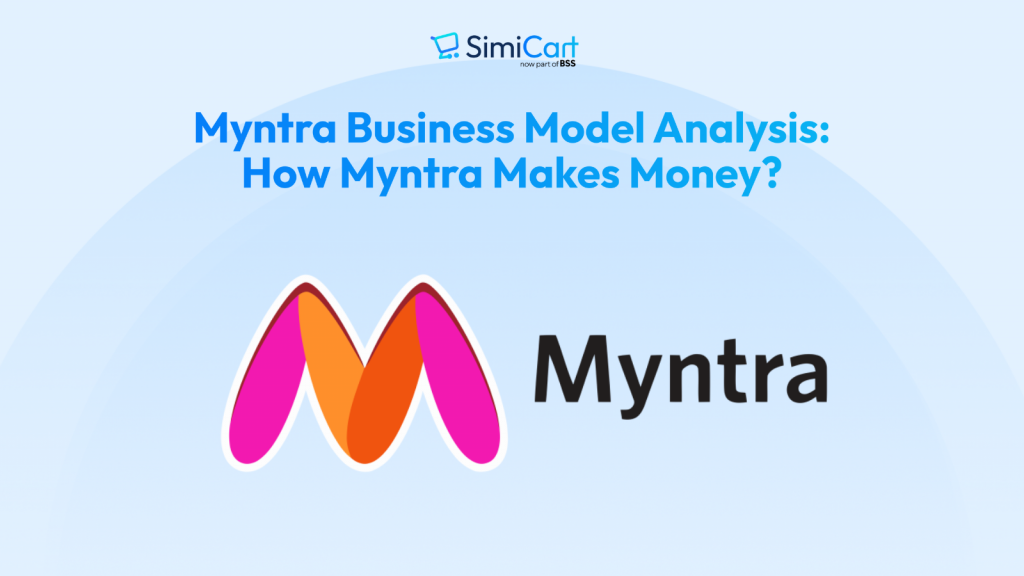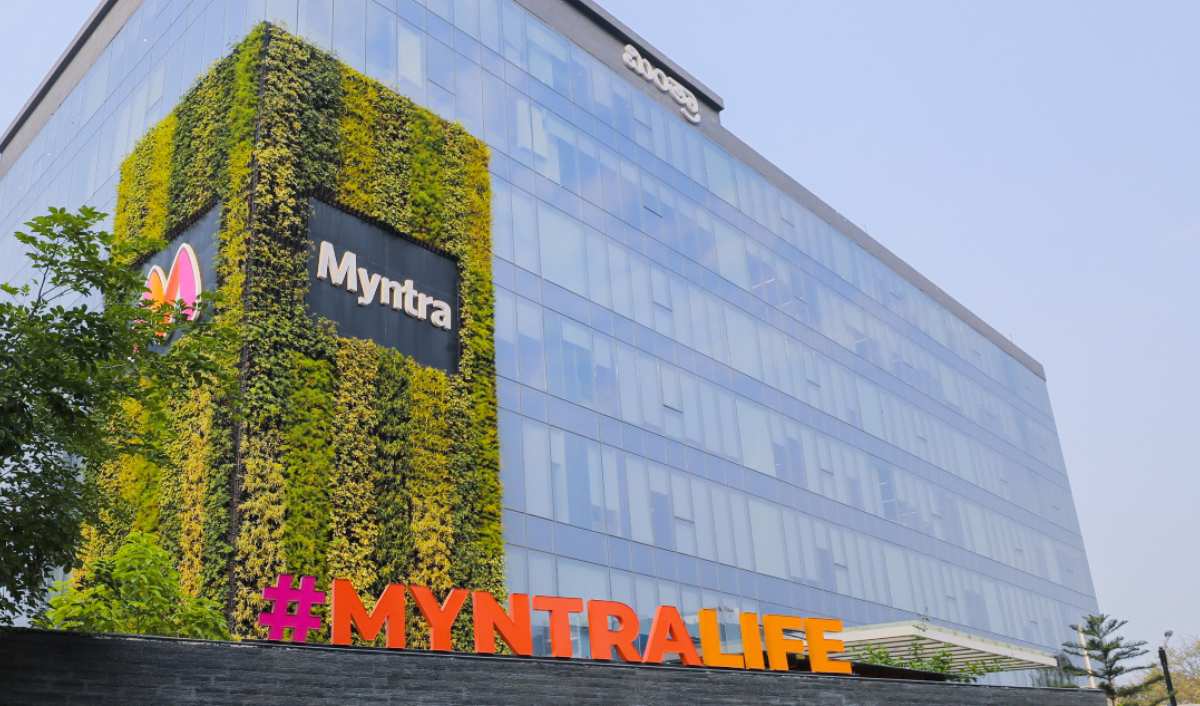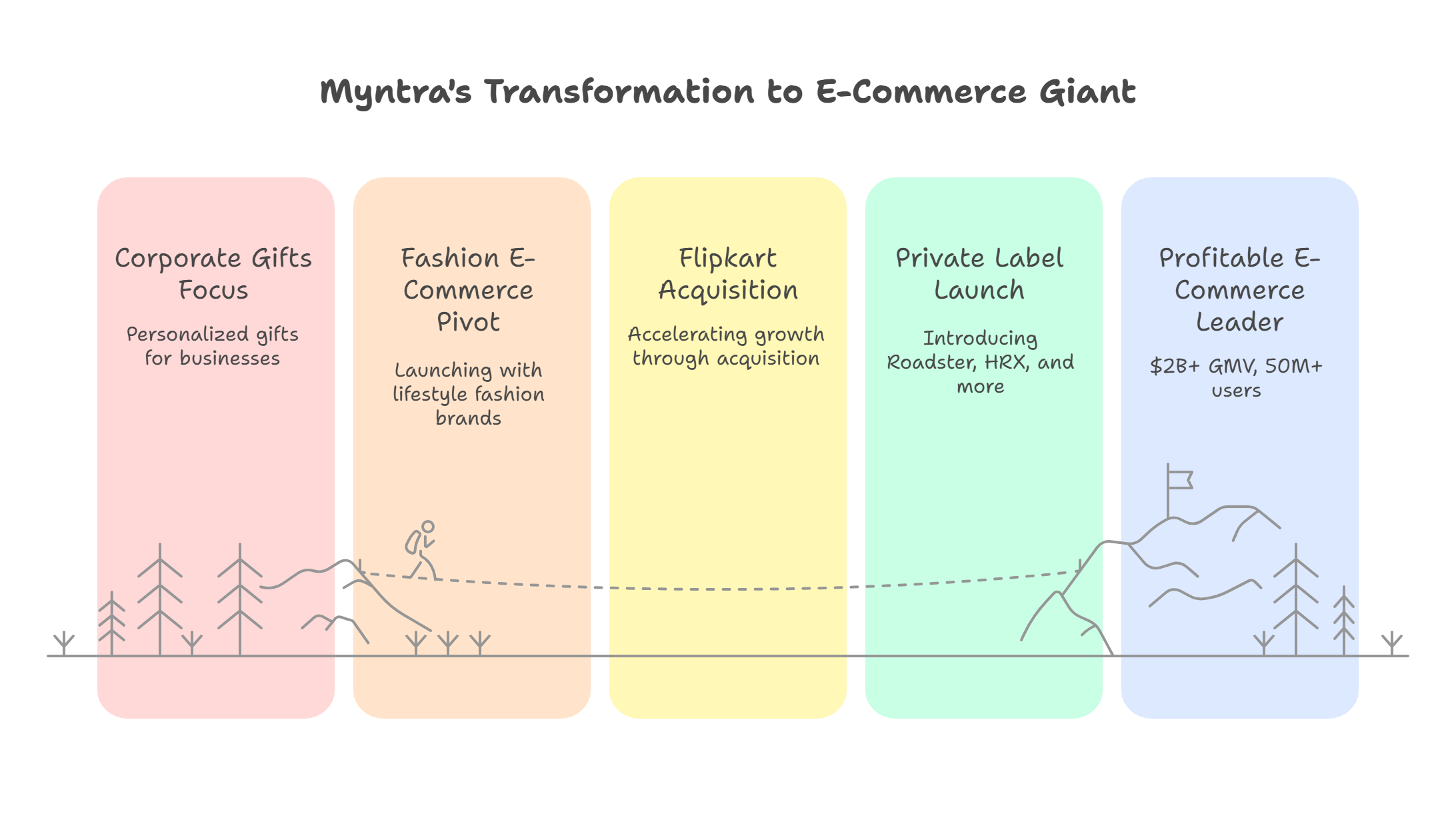Myntra Business Model Analysis: How Does Myntra Make Money?

The Myntra business model represents one of India’s most successful fashion e-commerce strategies, transforming from a B2B personalized gifts platform to the country’s leading fashion marketplace. With over 50 million monthly active users and processing more than $2 billion in gross merchandise value (GMV) annually, Myntra has established itself as a dominant force in Indian fashion retail.
This comprehensive analysis explores how Myntra makes money, examining its hybrid marketplace model, revenue streams, competitive advantages, and strategic innovations. For D2C brands, Shopify merchants, and e-commerce entrepreneurs, understanding Myntra’s business model provides valuable insights into scaling fashion platforms, optimizing revenue streams, and building sustainable competitive moats in the digital marketplace.

Myntra Company Profile & Evolution
Company Overview
Founded in 2007 by Mukesh Bansal, Ashutosh Lawania, and Vineet Saxena in Bengaluru, Myntra began as a B2B platform selling personalized gifts to corporations. The company underwent a strategic pivot in 2010, transitioning to B2C fashion retail under the vision of becoming India’s largest fashion destination. Acquired by Flipkart in 2014 for approximately $300 million, Myntra operates as an independent subsidiary while leveraging Flipkart’s logistics infrastructure and Walmart’s global retail expertise.
The Myntra business model evolved from a traditional inventory-led approach to a sophisticated hybrid marketplace that combines third-party seller partnerships with private label development and strategic brand collaborations.
Key Milestones
- 2007: Founded as Myntra, focusing on personalized corporate gifts
- 2010: Strategic pivot to fashion e-commerce, launching with lifestyle brands
- 2011: Raised Series A funding, expanded product categories
- 2014: Acquired by Flipkart for $300 million, accelerating growth
- 2015: Controversial app-only strategy (later reversed in 2015)
- 2016: Launched private labels including Roadster, HRX, and All About You
- 2018: Achieved operational profitability in select quarters
- 2020: Launched M-Now for quick commerce, expanded beauty and home categories
- 2023: Sustained profitability with $2+ billion GMV and 50+ million users

How Myntra’s Business Model Works
Marketplace Model & Platform Structure
The Myntra business model operates as a hybrid platform combining marketplace facilitation with inventory-led private label operations. The marketplace component connects over 4,000 fashion brands and sellers with consumers, charging commission rates ranging from 4-20% depending on product categories and brand partnerships. This dual approach allows Myntra to maintain high inventory turnover while maximizing profit margins through exclusive products.
| Aspect | Marketplace Model | Private Label Model |
| Margin Control | 4–20% commission | 40–60% gross margins |
| Inventory Risk | Zero inventory holding | Full inventory responsibility |
| Brand Control | Limited influence | Complete creative control |
| Supply Chain | Seller-managed fulfillment | End-to-end management |
| Scalability | High with minimal investment | Requires significant capital |
Fulfillment Models (PPMP, JIT, M-Direct)
Myntra’s Pure Play Marketplace Program (PPMP) enables sellers to maintain inventory control while accessing Myntra’s customer base and logistics network. Through API and OMS (Order Management System) integration, sellers receive real-time inventory updates, automated order processing, and seamless payment reconciliation. The platform charges sellers for logistics services based on weight, distance, and delivery speed, creating additional revenue while maintaining operational flexibility.
The Just-in-Time (JIT) model allows Myntra to reduce inventory carrying costs for fast-moving products, while M-Direct enables direct brand partnerships with premium labels seeking exclusive distribution channels. This multi-modal approach optimizes the Myntra business model by balancing inventory risk, margin optimization, and customer experience.
Technology & Customer Experience
Myntra’s technology-first approach differentiates its business model through several key innovations:
- Mobile-first dominance: Over 95% of orders originate from mobile devices, with app-exclusive features driving engagement
- AI-driven personalization: Machine learning algorithms analyze browsing patterns, purchase history, and demographic data to deliver personalized product recommendations
- AR try-on technology: Virtual fitting rooms and augmented reality features reduce return rates while enhancing customer confidence
- Content-commerce integration: Myntra Studio provides fashion content, styling tips, and influencer collaborations, while M-Live offers live commerce experiences

Myntra Revenue Model: How Myntra Makes Money?
Revenue Streams Breakdown
The Myntra business model generates revenue through six primary streams:
- Marketplace Commissions (4-20%): Take rates vary by category, with higher commissions for premium brands and accessories. Fashion accessories command 15-20% commissions, while basic apparel ranges from 4-12%.
- Private Label Sales (40-60% margins): Myntra’s private labels including Roadster, HRX, All About You, and Mast & Harbour generate significantly higher margins compared to marketplace commissions, contributing approximately 25% of total revenue.
- Advertising and Retail Media: Sponsored product listings, banner advertisements, and brand promotion campaigns generate substantial advertising revenue. Brands pay for premium placement, search ranking optimization, and targeted marketing campaigns.
- Logistics Services Fees: Fulfillment services, warehousing, and last-mile delivery generate additional revenue from both marketplace sellers and direct brand partners.
- Loyalty and Subscription Programs: Myntra Insider program drives repeat purchases through exclusive access, early sale previews, and accelerated delivery options.
- Consulting and Brand Enablement: Strategic consulting services for D2C brands entering Indian markets, including market research, pricing optimization, and digital marketing support.
Example Revenue Split (Latest Data)
Based on FY2024 financial disclosures and industry analysis:
- Marketplace Commissions: 45-50% of total revenue
- Private Label Sales: 25-30% of total revenue
- Advertising Revenue: 8-12% of total revenue
- Logistics and Services: 5-8% of total revenue
- Other Revenue Streams: 3-5% of total revenue
Myntra achieved sustained profitability through strategic cost optimization including tighter return policies (reducing return rates from 30% to under 15%), logistics network optimization, and focus on high-margin private label expansion.
Cost Structure & Profitability Focus
Key Cost Drivers
The Myntra business model manages several significant cost categories:
- Marketing and Promotions: 35-40% of revenue during peak seasons, including influencer partnerships and digital advertising
- Technology Infrastructure: Cloud computing, mobile app development, AI/ML capabilities, and cybersecurity investments
- Logistics and Warehousing: Last-mile delivery, warehousing operations, and return processing infrastructure
- Personnel Costs: Technology talent, category managers, customer service, and regional operations teams
- Procurement and Inventory: Private label manufacturing, vendor financing, and inventory carrying costs
>> See more: Myntra Marketing Strategy: Bold Moves That Work
Recent Path to Profitability
Myntra’s journey to sustained profitability involved multiple operational optimizations. Dynamic platform fees adjust commission rates based on demand patterns and inventory turnover. The focus on high-margin private labels and premium brand partnerships improved average order values (AOV) while reducing customer acquisition costs. Strategic investment in express delivery and Q-commerce capabilities increased customer lifetime value through improved satisfaction scores and repeat purchase rates.
Key FAQs About Myntra’s Business Model
Myntra generates revenue through marketplace commissions (4-20%), private label sales (higher margins), advertising fees, logistics services, and subscription programs.
Myntra transitioned from B2B corporate gifts (2007-2010) to B2C fashion marketplace. Current B2B elements include seller partnerships and brand enablement services.
Commission rates range from 4-20% depending on product categories, brand partnerships, and seller performance tiers.
Private labels contribute 25-30% of revenue with 40-60% gross margins, significantly higher than marketplace commission income.
Key challenges include high customer acquisition costs, managing return rates, competing with global platforms, and expanding beyond metropolitan markets.
Focus on mobile-first experiences, develop strong private label strategies, implement personalization technology, and create strategic influencer partnerships.
Transform Your E-commerce Strategy with Mobile-First Innovation
The Myntra business model demonstrates the power of mobile-first commerce, strategic private labeling, and technology-driven personalization. For Shopify merchants and D2C founders, these insights highlight critical success factors in building scalable fashion platforms.
Key takeaways for implementing Myntra’s strategies:
- Prioritize mobile app development with seamless user experiences
- Develop exclusive product lines with higher margin potential
- Invest in AI-driven personalization and recommendation systems
- Build strategic influencer partnerships for authentic brand promotion
- Optimize logistics and fulfillment for customer satisfaction
Ready to transform your e-commerce platform with mobile-first innovation? Explore how SimiCart’s Shopify mobile app solutions can help you implement Myntra-inspired strategies, optimize customer experiences, and drive sustainable growth in today’s competitive marketplace.


